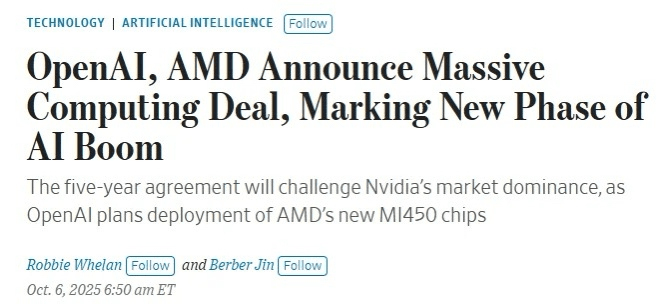1.
Training large models
Models like OpenAI's GPT-4/5 require millions of GPU-level chips (A100, H100, MI300, etc.) for large-scale training.
NVIDIA's H100 has been in short supply for a long time, and its price is high (around $30,000 to $40,000 per card), while AMD's MI300 series is currently the only alternative that can come close to the H100 in terms of computing power and energy efficiency.
Purchasing a large number of AMD chips can enable OpenAI to:
Reduce dependence on NVIDIA;
Expand the training computing power pool to support training for GPT-5/6 and multimodal models (video, 3D, audio);
Distributed training: To build models with 'hundreds of trillions of parameters' in the future, a massive GPU cluster is essential.
2.
Inference and productization
Training is just the first step; the real cost comes from inference (real-time computation when users call).
ChatGPT, API, Copilot are called billions of times daily, requiring massive GPU resources to run models in real time.
Uses include:
ChatGPT user services (dialogue, voice, image understanding);
Enterprise API calls (Microsoft Copilot, Azure OpenAI);
Future hardware devices (such as AI glasses, pins) that require low-latency cloud inference support.
If there is not enough computing power, user experience will drop or delay, affecting competitiveness.
3.
Strategic level: Self-built AI supercomputing center
OpenAI is deeply bound to Microsoft Azure, which provides the infrastructure. However, if OpenAI wants to ensure independence, it must have its own computing power.
Purchasing AMD chips may be used for:
Building a supercomputing center independently without fully relying on Microsoft;
Joint deployment with Microsoft/other cloud vendors, such as deploying AMD chips in Azure, AWS, Oracle's data centers;
Backup strategy: If the US imposes stricter export restrictions on NVIDIA in the future, AMD chips are a key alternative.
At the same time, OpenAI's large-scale purchases can also drive AMD to optimize its ROCm software ecosystem to be closer to CUDA levels.
4.
Possible new directions
Video generation models (Sora upgraded version): Video requires higher bandwidth and more computing power than text/images.
AI agents + tool calls: Need to run multiple models simultaneously, leading to a significant increase in computing power consumption.
Real-time multimodal interaction (GPT-4o/5): Supports voice + vision + action, with substantial inference behind it.
Future hardware support: If OpenAI launches AI glasses/wearable devices, they will mostly rely on 'cloud inference,' requiring a strong data center to support them.
✅ Summary
The main uses of the hundreds of billions of dollars worth of AMD chips purchased by OpenAI are:
Large model training (GPT-5/6, multimodal models);
Large-scale inference (ChatGPT, API, enterprise services, future hardware);
Strategic computing power reserves (self-built/jointly built AI supercomputing centers to reduce dependence on NVIDIA).
In other words, this is part of the 'computing power arms race,' aimed at ensuring that OpenAI continues to lead in model scale and service experience over the next 3–5 years.
